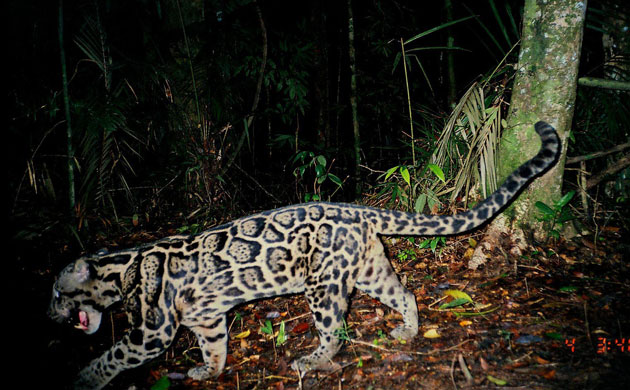TOP STORIES  Scientists: What's killing all the gray whales?
Scientists: What's killing all the gray whales?
Scientists are planning to cut open and examine a newly dead gray whale found on a local beach in hopes it can provide insight into what's killing so many of the large marine mammals in Puget Sound this year.
. . . In the past 10 days, five dead gray whales have been found - four in Puget Sound waters and the fifth near Vancouver, B.C. Three of those have died just in the past week.
Gorman said that is an unusually high number in such a short time span, and scientists aren't sure what is causing the high death rate.
15 Apr 2010
Photo courtesy of KOMO News
 Establishment of a northeast wildlife disease consortium
Establishment of a northeast wildlife disease consortiumThe 66th Annual Northeast Fish and Wildlife Conference is being held in Newton, Massachusetts, April 25 - April 27 is hosting the session, Wildlife Disease and Health. Included in this session will be a panel presentation, Establishment of a northeast wildlife disease consortium.
The following groups, Cummings School of Veterinary Medicine, Tufts University; NH Veterinary Diagnostic Laboratory, University of New Hampshire; and the Department of Pathobiology and Veterinary Science, University of Connecticut, propose to establish the Northeast Wildlife Disease Consortium (NWDC), a state, federal, and private sector cooperative structure that provides wildlife health and disease expertise in the Northeast U.S. The Consortium would comprise state governments, local people, and the private and public (i.e.- non-profit) sectors who, in collaboration, investigate disease and manage the health of wildlife populations in the Northeastern U.S. The Consortium's dedication to wildlife health in this region alone would address chronic challenges to getting prompt and timely results in disease investigations, providing diagnostics both for live specimens and carcasses.
66th Annual Northeast Fish and Wildlife Conference - http://www.neafwa.org
15 Apr 2010
Image courtesy of the Northeast Association of Fish and Wildlife Agencies
 White nose decimates Vt. bat population
White nose decimates Vt. bat populationAs the sun begins to set on Mount Aeolus, wildlife biologists are making the two-mile climb to Vermont's largest bat cave... fearful of what they may find.
"It's been a long time since we've seen a live one," commented Scott Darling of the Vt. Fish & Wildlife Department.
. . . Up until very recently the Mount Aeolus cave was the largest bat cave in all of New England with upwards of 300,000 bats. Today those numbers have dwindled to only a couple hundred.WCAX News - www.wcax.com
14 Apr 2010
K Harsha
Photo courtesy of WCAX News
The Factors Behind Geography Of Human Disease
If your home region has a hot, wet climate and a lot of different kinds of birds and mammals living in it, there's a really good chance the region will also contain numerous kinds of pathogens that cause human diseases.
A new study examining the geography of human disease, led by Dr. Rob Dunn at North Carolina State University alongside an international team of biologists and social scientists, shows that that one can predict the number of kinds of disease-causing pathogens in a region just by knowing its climate or the number of birds and mammals found there.
Multiple things, Dunn says, might influence the diversity of pathogens in a region: human population size and density, the amount of time people have lived there or expenditures on disease control. Each of these undoubtedly has some influence, but the environment is dominant.
16 Apr 2010
TOP READ LINKS FROM LAST WEEK
News
- Outbreak Study: Satellite Tracking Reveals How Wild Birds May Spread Avian Flu [USGS Press Release]
- Emergence of zoonotic arboviruses by animal trade and migration
- Warning over unclean bird feeders
- Bushmeat Diseases Entering New York
- Octopus vs. Sea Lion—First Ever Video
- Harnessing the Web and supercomputers to track pathogens as they evolve
- California Condor Chick Hatched In The Wild: First Time In More Than 50 Years
- Frog tadpoles 'scream' underwater discover scientists
- 2 gray whales dead on NW Wash. beaches
- In the Spotlight - 59th Annual Wildlife Disease Association Meeting
- Vaccination strategies for managing brucellosis in Yellowstone bison
- Brucellosis in the United States: Role and significance of wildlife reservoirs
- Bartonellosis: an emerging infectious disease of zoonotic importance to animals and human beings
OTHER WILDLIFE HEALTH RELATED NEWS
Photo credit: Wai-Ming Wong/Chester Zoo
 The week in wildlife [image gallery]
The week in wildlife [image gallery]- Cheboygan County deer tests positive for TB [domestic animal; Location: Cheboygan County, Michigan, USA - Map It
 ]
] - Nantucket prepares for severe red tide outbreak
- Sierra Nevada Yellow-Legged Frog's Site Fidelity May Lead to Further Decline
- Contingency plan to fight viral diseases in Kirthar
- Scientists Say Tests Show Dangers in So-Called Bushmeat
- Oceans' Saltiness Reaching Extremes
- Fresh water may have harmed dolphins [submitted by the Australian Wildlife Health Network]
- U.S. leads new bid to phase out whale hunting
- Invading Species Carrying Parasites Have Healthy Appetites [includes audio]




